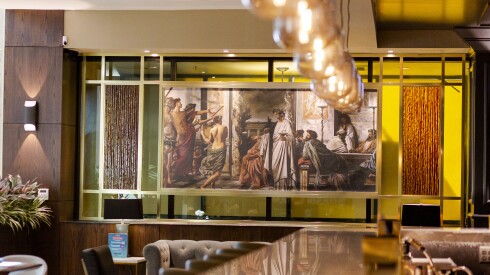I almost hesitated when I got the chance to try my first electric-assist bike on a tour of Monterey Bay. The whipping wind, the hilly central California countryside, the need to keep up with a group on a longer bike ride than I’d taken in months—it was all daunting. Ultimately, my curiosity won out, and as I turned into a headwind that came off Spanish Bay, I quickly discovered the technology’s allure. As I pedaled hard, my bike—a Turbo Como 2.0 from Specialized—gave back in equal measure. The harder I worked, the harder the motor worked, and I zipped forward with an ease I could get used to. I let out an elated whoop, laughing like a kid conquering two wheels for the first time.
Electric-assist bicycles have been popular in Europe for about 10 years, according to Dominik Greyer, Specialized’s product manager for the Turbo, and in 2017, more than 2.3 million e-bikes were sold on the continent. Until recently, however, electric bikes were relatively unheard of in the United States and looked down on by local hard-core cyclists.

E-bikes allow people of different experience levels to enjoy rides together.
Courtesy of DuVine Cycling + Adventure Co.
Even among those who had heard the phrase “e-assist,” the concept was prone to misunderstanding. Despite the fact that the bikes use a battery-powered motor that’s only activated by pedaling, people pictured noisy throttles and gasoline engines. “It was seen as not really biking,” says Tania Burke, president of the cycling outfitter Trek Travel. “But it’s not like a moped. You have to pedal. [The motor] is just there to assist you.” E-bikes have finally started shedding their stigma in the United States, and in 2018 they’re poised to change the way you travel here. Greyer notes that, although the bikes were designed with the 35 and over crowd in mind, they are now also making headway with a young generation of riders who embrace technology. Sales are soaring: Specialized is seeing a 90 percent increase over last year.
Why the sudden love affair with pedal-assist bicycles?
The appeal lies in their ability to level the playing field. They let couples, friends, and family who have different fitness and experience levels travel together. They give people just enough boost to try routes otherwise outside their comfort zones. And because riders don’t tire as quickly, they stay in the saddle longer.
“I call it a game-changer for so many people.”
Most travelers have their first encounter with e-bikes on a long-distance tour. More than two-thirds of Trek Travel customers who opt for e-bikes on a Trek trip are new to bicycle touring, often accompanying a more experienced friend or partner. Burke recalls a trip along one of her favorite cycling routes through Tuscany’s rolling countryside with her mother-in-law. “She was riding with me up the climb, and we had a ball. She most likely wouldn’t have been able to do that had she not been on an e-bike. I call it a game-changer for so many people,” she says.
For the past several years, bike tour companies like Trek Travel and DuVine Cycling + Adventure Co. have watched requests climb. In 2016, 66 DuVine customers used e-bikes on tours. In 2017, that number had jumped to 153 and is predicted to exceed 200 by the end of this year. “Our guests are loving electric assist,” says founder Andy Levine. “E-bikes . . . are great equalizers.”
Multi-day adventures also offer experienced riders the chance to sample the technology without committing, so DuVine and Trek Travel now bring e-bikes on most of their tours, even if they’re not requested.
But the bikes aren’t just useful for travelers who want to log miles in rolling rural landscapes. They’re becoming an increasingly popular option for revving up a day trip.
Happy Friday! Here’s your daily dose of amazingness... biking along Scenic Drive in Carmel on the Vintage Electric Cafe as the sun is going down. A post shared by Mad Dogs & Englishmen (@maddogscarmel) on Apr 27, 2018 at 8:08pm PDT
Dockless electric-assist bike sharing programs, such as JUMP in San Francisco and Washington, D.C., are becoming more popular with local commuters and independent tourists. Darting through D.C.’s traffic or tackling the Bay Area’s hills on a regular bike can be too much for most residents, let alone visitors, but the boost of the pedal-assist makes this type of active urban travel more accessible.
Bike shops and outfitters across the country are starting to incorporate e-bikes into their guided local tours too. Mad Dogs & Englishmen, opened earlier this year in Carmel-by-the-Sea, can coordinate a morning e-bike ride taking in Monterey’s historic sites in chronological order (which isn’t possible on foot) or an afternoon e-bike ride along California’s famous 17-mile drive. In Colorado Springs, Amp’d Adventures guides 60-minute to three-hour fat-tire e-bike tours that wind on- and off-road through the juniper-laden foothills and candy cane sandstone spires of the Garden of the Gods.
The biking community in the mountains has been the slowest to accept e-bikes, but even that is changing. Last summer, Steamboat Ski & Resort in northern Colorado opened its mountain bike park to guided e-bike lessons and tours. And on May 25, Mammoth Bike Park will become the first U.S. Forest Service bike park to permit electric-assist bikes. Just as they do on the road, e-bikes open up the mountains to people of varying experience and fitness levels.
DuVine’s Andy Levine says that e-bikes “make a dream vacation a reality.”
>>Next: How to Explore America’s Most Underrated Biking City











